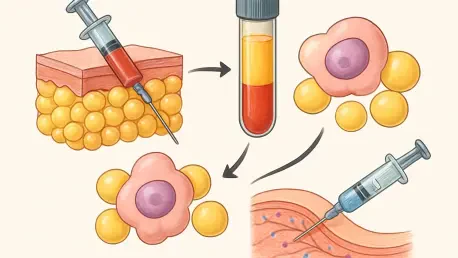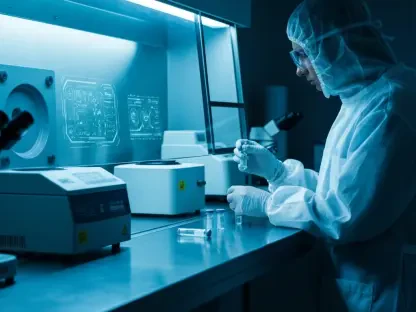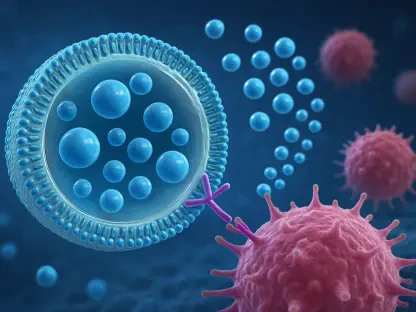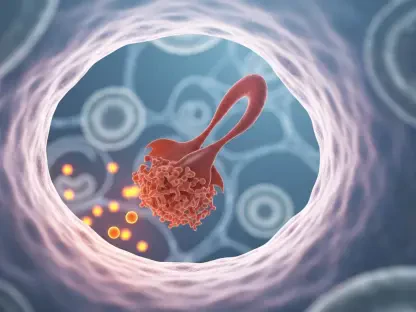Imagine a world where damaged tissues and organs can be repaired using a resource readily available in the human body, transforming the landscape of medical treatment as we know it today. This vision is inching closer to reality with the remarkable advancements in fat stem cell research, a field gaining significant traction globally. In South Korea, a groundbreaking initiative has emerged with the establishment of a dedicated society focused on harnessing the potential of fat-derived stem cells for regenerative therapies. This development marks a pivotal moment, uniting medical experts and researchers under a shared mission to push the boundaries of healing and recovery. By tapping into the unique properties of fat as a rich source of stem cells, this movement promises to address some of the most pressing challenges in modern medicine, offering hope for innovative treatments that could redefine patient care.
Pioneering a New Era in South Korea
Launch of a Groundbreaking Medical Society
The formation of the Korean Society of Fat Stem Cellology stands as a landmark achievement in the realm of regenerative medicine. Officially launched during an inaugural general meeting held at the Grand Mercure Ambassador Imperial Palace in Seoul, this integrated medical platform brings together leading experts from diverse clinical fields such as orthopedic surgery, plastic surgery, and rehabilitation medicine. The society’s leadership, with Kim Jong-un from 365mc All New Gangnam headquarters elected as chairman and Cho Min-young from Ttuk Clinic as vice chairman, reflects a strong commitment to advancing this specialized area. Supported by executive directors and esteemed advisors like Professor Heo Chang-hoon from Seoul National University Bundang Hospital, the organization is well-positioned to drive meaningful progress. This launch not only signifies a unified effort to explore fat stem cell applications but also sets a foundation for rigorous scientific exploration and clinical innovation within South Korea’s medical community.
Building a Collaborative Network for Progress
Beyond its inception, the society aims to foster a collaborative environment where knowledge and expertise can flourish. Comprising specialists who actively apply fat stem cells in treatments, alongside researchers from major university hospitals, the group is dedicated to sharing insights and developing best practices. Regular academic conferences and the creation of research consultative bodies are among the planned initiatives to ensure continuous dialogue and advancement. Additionally, the involvement of honorary advisors like Professor Seo Hong-seok from Korea University Medical School adds a layer of credibility and strategic guidance. This network is not just about local impact; it seeks to contribute to global academic development by promoting international cooperation. By uniting such a diverse pool of talent, the society endeavors to tackle complex challenges in regenerative therapies, ensuring that innovations are both scientifically sound and practically applicable to enhance patient outcomes across various medical disciplines.
Unlocking the Potential of Fat-Derived Stem Cells
A Superior Source for Regenerative Therapies
One of the most compelling aspects of fat stem cells lies in their abundance compared to other sources. Research indicates that fat tissue contains approximately 500 times more stem cells than bone marrow and an astonishing 25,000 times more than cord blood, making it a highly viable option for therapeutic use. This vast quantity positions fat as a practical alternative, especially in regions like South Korea where legal constraints limit stem cell culture practices. Furthermore, the ability to bank fat stem cells for up to 23 years adds significant value to their clinical potential, offering long-term solutions for patients. During the society’s inaugural discussions, emphasis was placed on these unique advantages, highlighting how such a resource could transform treatment approaches. The focus on leveraging this natural abundance underscores a shift toward more accessible and sustainable regenerative options that could benefit a wide range of medical conditions.
Standardizing Safety and Clinical Practices
Equally critical to the advancement of fat stem cell therapies is the commitment to safety and standardization, a core mission of the newly formed society. Chairman Kim has articulated a vision centered on scientific evidence and patient well-being, advocating for the establishment of clinical guidelines to regulate adipose stem cell treatments. This includes rigorous safety verification processes and technology standardization to ensure consistency and reliability in therapeutic applications. The society plans to support these goals through ongoing research initiatives and academic exchanges that prioritize public health. By creating a structured framework for innovation, the organization aims to mitigate risks and build trust in these emerging therapies. Such efforts are vital for gaining broader acceptance within the medical community and among patients, paving the way for fat stem cells to become a cornerstone of regenerative medicine with a focus on improving health recovery on a global scale.
Reflecting on a Transformative Milestone
Shaping the Future of Healing
Looking back, the launch of the Korean Society of Fat Stem Cellology represented a defining moment in the journey of regenerative medicine. It brought together a coalition of dedicated professionals who shared a vision of harnessing fat stem cells to address unmet medical needs. Their collective expertise across various specialties laid a robust groundwork for exploring clinical applications that were once thought to be out of reach. The emphasis on evidence-based practices during those initial discussions set a high standard for future endeavors, ensuring that every step forward was rooted in scientific integrity. This historic event not only spotlighted South Korea’s role in this cutting-edge field but also inspired a renewed focus on collaborative research that transcended borders, aiming to elevate global health standards through innovative therapies.
Next Steps for Global Impact
As the society solidified its foundation, attention turned to actionable strategies that could amplify its influence in the years that followed. Establishing international partnerships emerged as a key priority to exchange knowledge and accelerate advancements in fat stem cell research. Developing comprehensive training programs for medical professionals was also deemed essential to ensure the safe and effective implementation of these therapies worldwide. Moreover, continued investment in public awareness campaigns became a focal point to demystify the science behind fat stem cells and highlight their potential benefits. These steps, initiated in the wake of the society’s formation, were designed to sustain momentum and position fat-derived therapies as a mainstream solution in regenerative medicine, ultimately transforming how healthcare challenges are addressed on a global scale.









